Jigsaw puzzles offer a powerful way to access serenity and manage stress. They're not just a pastime; they're a form of therapy that triggers dopamine release and induces a meditative state. You'll stimulate both brain hemispheres, enhancing cognitive function and problem-solving skills. To maximize stress relief, choose puzzles that match your skill level and create a calming environment with good lighting and soothing sounds. Practice mindfulness techniques while puzzling, and don't forget to celebrate small victories along the way. Regular puzzling can lead to improved memory, focus, and emotional well-being. Discover how this simple activity can transform your mental landscape and promote lasting tranquility.
The Science Behind Puzzle Therapy
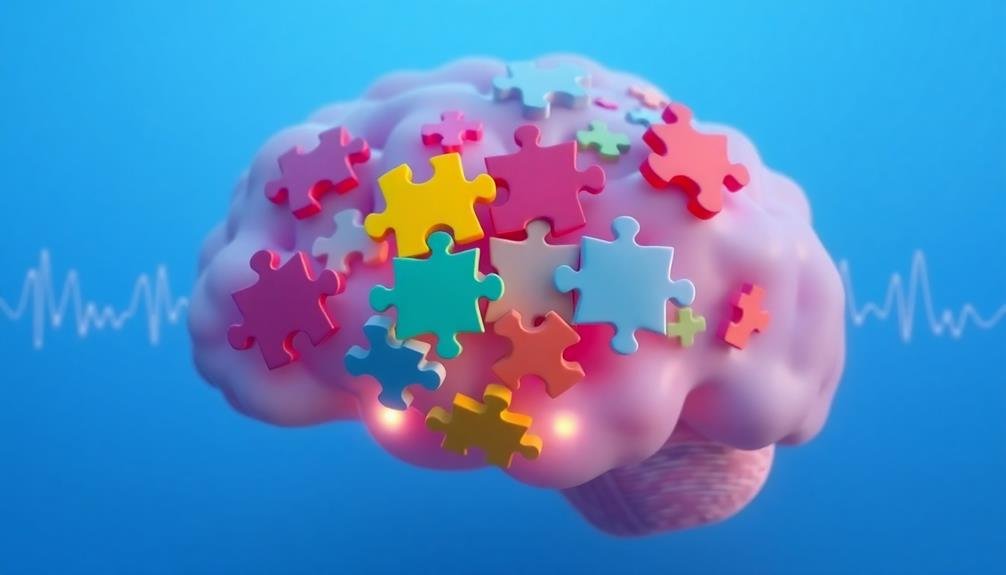
In the domain of stress relief, jigsaw puzzles have emerged as a powerful therapeutic tool. When you engage in puzzle-solving, your brain releases dopamine, a neurotransmitter associated with pleasure and reward. This chemical reaction creates a sense of accomplishment and motivation, encouraging you to continue the activity.
As you focus on fitting pieces together, your mind enters a meditative state. This state, similar to mindfulness practices, helps reduce anxiety and promotes relaxation. Your attention shifts away from stressors, allowing your brain to reset and recharge.
Puzzle therapy also stimulates both hemispheres of your brain. The left hemisphere, responsible for logical thinking, works on strategies and pattern recognition. Meanwhile, the right hemisphere, linked to creativity, processes colors and shapes. This balanced brain activity enhances cognitive function and problem-solving skills.
Moreover, completing a puzzle activates your visual-spatial reasoning abilities. As you manipulate pieces mentally and physically, you're strengthening neural connections. This process can improve your memory, concentration, and overall cognitive flexibility.
Choosing the Right Puzzle Difficulty
When selecting a jigsaw puzzle for stress relief, you'll want to match the difficulty level to your current skills and experience.
Assess your puzzle-solving abilities honestly, considering factors like piece count, image complexity, and any unique challenges like irregular shapes or double-sided designs.
Don't forget to factor in your available time, as choosing a puzzle that's too demanding for your schedule might add stress rather than alleviate it.
Assess Your Skill Level
Evaluating your skill level is essential for choosing the right puzzle difficulty. Consider your experience with jigsaw puzzles and how easily you've completed them in the past. If you're a beginner, start with puzzles that have 100-300 pieces and larger, more distinct shapes. These will help you build confidence and develop basic strategies.
For intermediate puzzlers, opt for 500-1000 piece puzzles with more complex images and smaller pieces. You'll find these challenging but not overwhelming.
If you're an advanced puzzler, look for 1000+ piece puzzles with intricate designs, gradual color changes, or repetitive patterns.
Don't be afraid to challenge yourself, but remember that the goal is stress relief. If a puzzle becomes frustrating, it's okay to step back and try an easier one.
Pay attention to how long it takes you to complete puzzles at different piece counts. This will give you a good indication of your skill level and help you choose puzzles that provide the right balance of challenge and enjoyment.
As you improve, gradually increase the difficulty to keep the activity engaging and rewarding. Your skill level will grow with practice, allowing you to tackle more complex puzzles over time.
Consider Time Constraints
Time management plays an essential role in choosing the right puzzle difficulty. Consider how much time you can realistically dedicate to puzzling each day or week. If you're busy with work and family commitments, opt for smaller puzzles with fewer pieces that you can complete in shorter sessions. These allow you to make progress without feeling overwhelmed or frustrated by a lack of time.
On the other hand, if you have more free time, you might enjoy tackling larger, more complex puzzles that require extended focus. These can provide a satisfying long-term project, giving you something to look forward to and work on gradually.
Keep in mind that puzzle difficulty isn't just about the number of pieces; factors like image complexity and color variations also impact completion time.
Don't forget to factor in your puzzling environment. If you have a dedicated space where you can leave your puzzle out, you'll have more flexibility with larger, time-consuming projects. If you need to pack up your puzzle frequently, stick to smaller ones that you can finish in a few sittings.
Creating a Relaxing Puzzle Environment
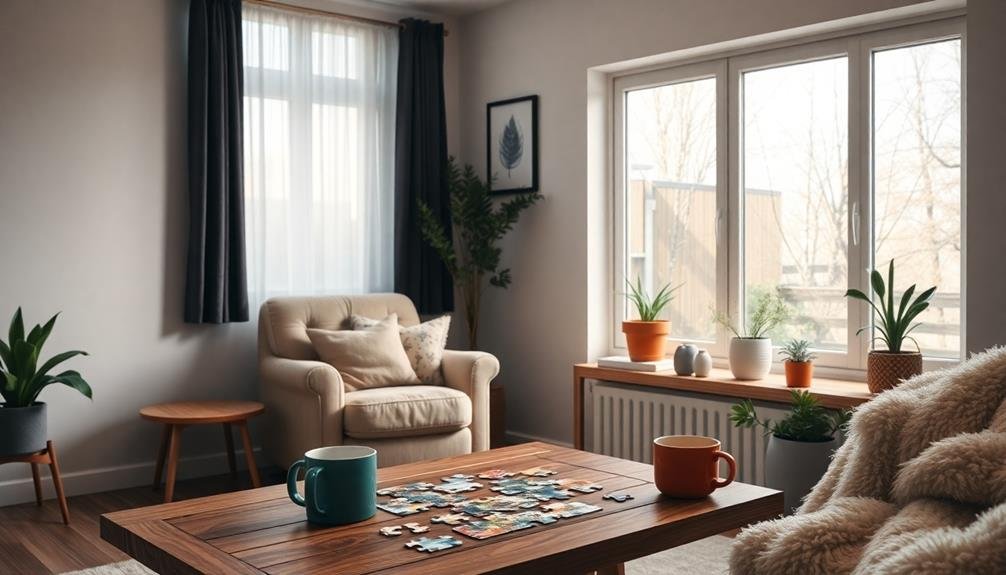
To maximize stress relief while puzzling, you'll need to set up a comfortable workspace and create a calming atmosphere.
Begin by choosing a well-lit area with a flat surface large enough for your puzzle and sorting pieces.
Add elements like soft background music, aromatherapy, or nature sounds to enhance relaxation and focus during your puzzling sessions.
Comfortable Puzzle Workspace Setup
Creating a comfortable and relaxing puzzle workspace is essential for maximizing your stress relief experience. Start by choosing a well-lit area with natural light if possible, or invest in a good task lamp to reduce eye strain.
Select a table or surface that's the right height for you to work comfortably, whether sitting or standing. Ascertain your chair provides proper back support and allows you to maintain good posture.
Keep your puzzle pieces organized using sorting trays or small containers. This will help you stay focused and reduce frustration. Consider using a puzzle mat or board that allows you to easily move your work-in-progress when needed.
Keep a magnifying glass nearby for examining small details.
Create a clutter-free zone around your puzzle area to minimize distractions. Have a water bottle and healthy snacks within reach to stay hydrated and energized.
Set up a small speaker for soothing background music or nature sounds if that helps you relax. Finally, make sure the room temperature is comfortable, as being too hot or cold can impact your concentration and enjoyment of the puzzle-solving process.
Calming Atmosphere Essentials
Beyond the physical setup, the ambiance of your puzzle space plays an essential role in stress relief. To create a calming atmosphere, focus on engaging your senses. Soft, warm lighting can reduce eye strain and promote relaxation. Consider using adjustable lamps or dimmer switches to customize the brightness. Natural light is also beneficial, so position your puzzle area near a window if possible.
Sound is another vital element. Choose soothing background noise that won't distract you from your puzzle. This could be gentle instrumental music, nature sounds, or even white noise. If you prefer silence, invest in noise-canceling headphones to block out any disruptive sounds.
Aromatherapy can enhance your relaxation. Use scented candles, essential oil diffusers, or incense to fill your space with calming fragrances. Some stress-reducing scents include:
- Lavender for promoting tranquility
- Peppermint for improving focus and clarity
- Eucalyptus for boosting mood and energy
Lastly, surround yourself with comforting textures. Soft throw blankets, plush pillows, and a cozy rug can make your puzzle space feel like a peaceful sanctuary.
Mindfulness Techniques While Puzzling
Puzzling can double as a mindfulness practice when you approach it with intention. As you sit down to work on your jigsaw puzzle, take a few deep breaths to center yourself. Focus on the present moment, letting go of any worries or distractions.
As you pick up each piece, notice its shape, color, and texture. Engage your senses fully in the experience. Pay attention to the sound of pieces clicking together and the feeling of satisfaction when you find a match. If your mind wanders, gently bring it back to the task at hand.
Practice non-judgmental awareness as you work. Don't criticize yourself for mistakes or slow progress. Instead, observe your thoughts and emotions without attaching to them. Embrace the process rather than fixating on the end result.
Use the puzzle as an opportunity to practice patience and persistence. When you feel frustrated, take a moment to acknowledge the feeling, then let it go. Remind yourself that each piece has its place, just as each moment contributes to your overall well-being.
Managing Frustration During Challenging Pieces
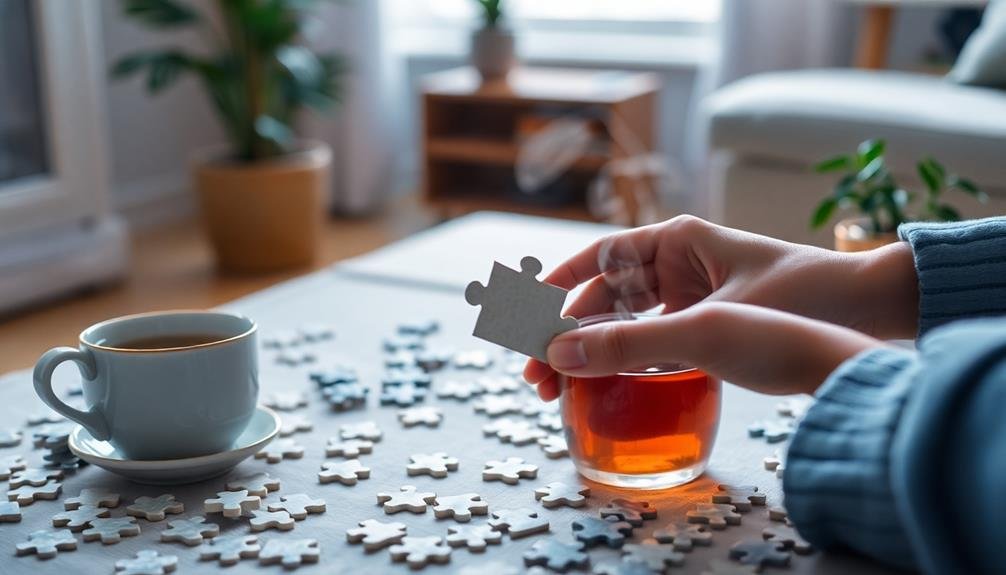
When you encounter difficult sections of your puzzle, don't let frustration derail your progress.
Instead, break complex areas into smaller, more manageable parts and focus on one piece at a time.
If you're still struggling, it's okay to step away for a strategic break, allowing your mind to reset before returning with fresh eyes and renewed determination.
Break Complex Sections Down
Frustration can quickly mount when faced with challenging sections of a jigsaw puzzle. To overcome this, break complex areas down into smaller, more manageable parts. This approach allows you to focus on specific details and make steady progress, reducing the overwhelming feeling that often leads to stress.
Start by identifying distinct features within the complex section, such as unique color patterns or shapes. Then, separate the pieces that belong to these features into smaller groups. This method helps you tackle the puzzle in bite-sized chunks, making it less intimidating and more enjoyable.
To effectively break down complex sections:
- Sort pieces by color or texture, creating mini-puzzles within the larger image.
- Focus on edge pieces first, establishing a framework for the challenging area.
- Look for distinctive patterns or objects, and work on completing those individually.
As you complete each smaller section, you'll experience a sense of accomplishment, boosting your motivation to continue.
Take Strategic Puzzle Breaks
Strategic breaks are essential when tackling challenging jigsaw puzzles. When you're feeling frustrated or stuck, step away from the puzzle for a short time. This break allows your mind to reset and often leads to fresh insights when you return. Don't push yourself to the point of exhaustion; instead, recognize when you need a breather.
During your break, engage in activities that refresh your mind and body. Here's a quick guide to effective puzzle breaks:
| Duration | Activity | Benefit |
|---|---|---|
| 5-10 min | Deep breathing | Reduces stress |
| 15-20 min | Light exercise | Boosts energy |
| 30 min | Change of scenery | Sparks creativity |
When you return to your puzzle, you'll likely find that pieces fall into place more easily. You might notice patterns or colors you'd previously overlooked. Remember, taking breaks isn't a sign of weakness; it's a smart strategy for maintaining focus and enjoyment. If you're working on a large puzzle, consider setting specific break times to avoid burnout. By incorporating strategic breaks, you'll enhance your puzzle-solving skills and maximize the stress-relief benefits of this engaging hobby.
Puzzle Strategies for Anxiety Relief
As you immerse yourself in jigsaw puzzling for anxiety relief, employing specific strategies can enhance the calming effects. Focus on the present moment, letting go of worries as you search for pieces.
Create a soothing environment with soft lighting and gentle background music to further reduce stress.
When anxiety peaks, try these targeted puzzle strategies:
- Color therapy: Sort pieces by color, focusing on shades that promote calmness like blues and greens. This process can be meditative and help regulate your emotions.
- Breathing exercises: Sync your breathing with your puzzling actions. Inhale as you pick up a piece, exhale as you place it. This mindful breathing can lower your heart rate and ease tension.
- Positive affirmations: As you connect pieces, mentally repeat calming phrases like "I'm making progress" or "I can solve this step by step." This practice reinforces a sense of accomplishment and control.
Social Puzzling for Stress Reduction
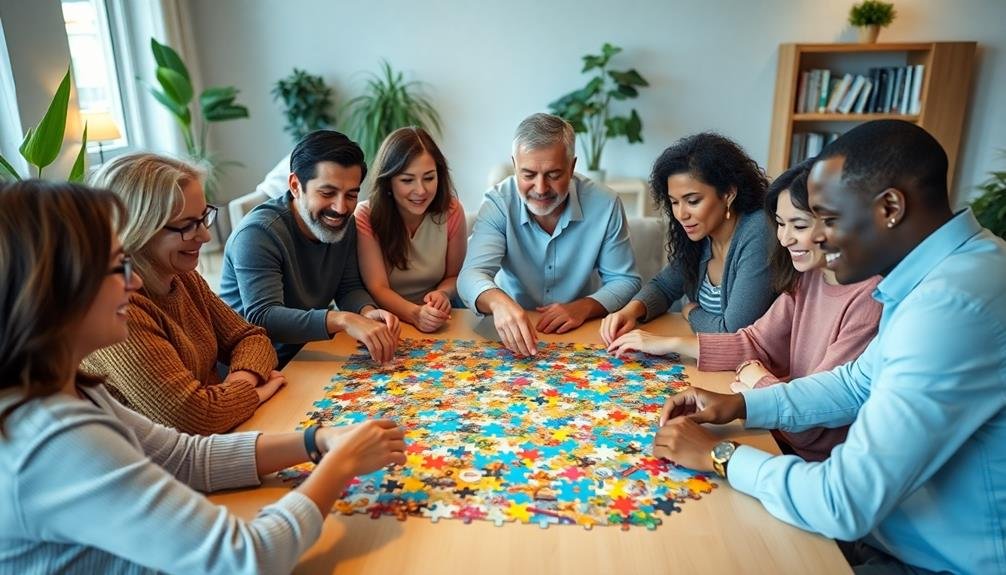
While puzzling alone can be therapeutic, engaging in social puzzling activities can amplify stress reduction benefits. You'll find that sharing the experience with others creates a supportive environment and fosters a sense of community.
Organize puzzle nights with friends or family, where you can work together on a challenging jigsaw. This shared activity promotes conversation, laughter, and bonding, all of which are excellent stress relievers.
Consider joining a local puzzle club or attending puzzle events in your area. These gatherings provide opportunities to meet like-minded individuals and expand your social circle. You'll learn new techniques from fellow enthusiasts and discover different puzzle styles you mightn't have encountered on your own.
Online puzzle communities are another great option for social puzzling. Join forums or social media groups dedicated to jigsaw puzzles, where you can share your progress, seek advice, and connect with puzzlers worldwide.
You might even participate in virtual puzzle-solving sessions or competitions.
Incorporating Puzzles Into Daily Routine
Incorporating puzzles into your daily routine doesn't have to be a challenging task. In fact, it can be an enjoyable way to unwind and de-stress throughout your day.
Start by setting aside a specific time for puzzling, whether it's during your morning coffee, lunch break, or before bed. Keep a puzzle in progress on a dedicated table or board, allowing you to work on it whenever you have a few spare minutes.
To make puzzling a consistent part of your routine:
- Set a daily goal, such as completing a certain number of pieces or working on the puzzle for a set amount of time.
- Use puzzles as a reward system for completing other tasks or as a shift between work and leisure activities.
- Involve family members or roommates, turning puzzling into a shared activity that fosters connection and relaxation.
Benefits of Digital vs. Physical Puzzles
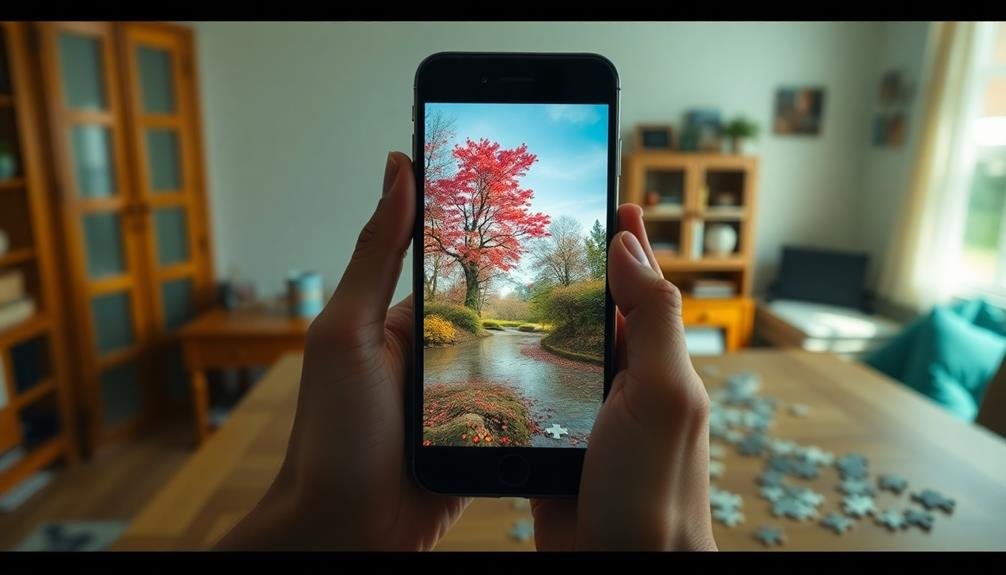
In recent years, the world of jigsaw puzzles has expanded beyond traditional cardboard pieces to include digital versions. As you explore both options, you'll find unique benefits to each format.
Physical puzzles offer a tactile experience that many find satisfying. You'll engage your sense of touch as you handle and sort pieces, which can be particularly soothing. They also provide a break from screen time, allowing your eyes to rest from digital strain. On the other hand, digital puzzles offer convenience and portability. You can easily access them on your devices, making them perfect for on-the-go puzzle solving.
Here's a quick comparison of digital and physical puzzles:
| Aspect | Digital Puzzles | Physical Puzzles |
|---|---|---|
| Storage | Minimal space | Requires storage |
| Portability | High | Limited |
| Tactile experience | None | Significant |
When choosing between digital and physical puzzles, consider your lifestyle and preferences. If you enjoy the feel of puzzle pieces and have ample space, physical puzzles might be your best bet. However, if you're often on the move or prefer the convenience of digital formats, you'll likely appreciate digital puzzles more. Ultimately, both options can provide effective stress relief and cognitive benefits.
Puzzle Accessories for Enhanced Relaxation
To further enhance your jigsaw puzzle experience and maximize relaxation, contemplate adding some carefully chosen accessories to your puzzle-solving routine. A puzzle mat or board allows you to easily move your work-in-progress, freeing up table space and giving you the flexibility to puzzle anywhere.
Invest in good lighting, like an adjustable desk lamp, to reduce eye strain and create a cozy atmosphere. Don't forget about storage solutions, such as stackable sorting trays or puzzle piece organizers, to keep your workspace tidy and stress-free.
For ultimate comfort during long puzzle sessions, try these additional items:
- A supportive, ergonomic chair to maintain good posture
- Soft background music or nature sounds to create a calming ambiance
- A timer to remind you to take regular breaks and stretch
You might also want to contemplate puzzle glue and a frame to preserve your finished masterpieces.
Celebrating Small Victories in Puzzling
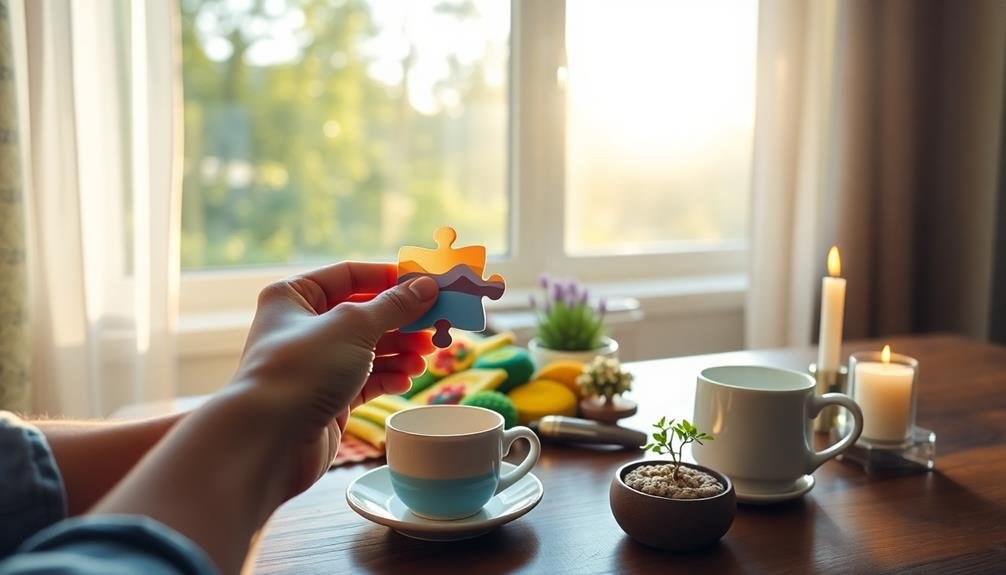
Small victories are the building blocks of satisfaction in jigsaw puzzling. As you work through your puzzle, take a moment to acknowledge each milestone you reach. Found that elusive corner piece? Celebrate it! Completed a challenging section? Give yourself a pat on the back.
These small wins contribute to your overall sense of achievement and help maintain your motivation.
Don't hesitate to share your progress with others. Post updates on social media, or show your family and friends. Their encouragement can boost your mood and provide additional motivation.
Set mini-goals for yourself, like completing the border or finishing a specific color section. When you reach these goals, reward yourself with a short break or a favorite snack.
Keep track of your puzzle-solving time and try to improve it gradually. You'll notice that as you become more skilled, you'll solve puzzles faster, which is another reason to celebrate.
Puzzle Themes for Mood Improvement
Selecting the right puzzle theme can greatly impact your mood and stress levels. When you're feeling down or anxious, choose puzzles with uplifting imagery that transports you to a calmer state of mind. Nature scenes, like lush forests or serene beaches, can help you feel more connected to the outdoors and promote relaxation.
Vibrant cityscapes or colorful abstract designs might boost your energy and creativity, perfect for when you need a pick-me-up.
Consider these themes for specific mood improvements:
- Tranquil landscapes: Mountains, lakes, or gardens to induce calmness
- Cute animals: Puppies, kittens, or baby wildlife to spark joy and affection
- Nostalgic scenes: Vintage artwork or retro designs to evoke happy memories
Don't underestimate the power of color in your puzzle choices. Warm hues like yellows and oranges can promote optimism, while cool blues and greens encourage serenity.
If you're struggling with focus, opt for puzzles with intricate details or patterns that demand concentration, helping to quiet racing thoughts and center your mind on the present moment.
Long-term Effects of Regular Puzzling
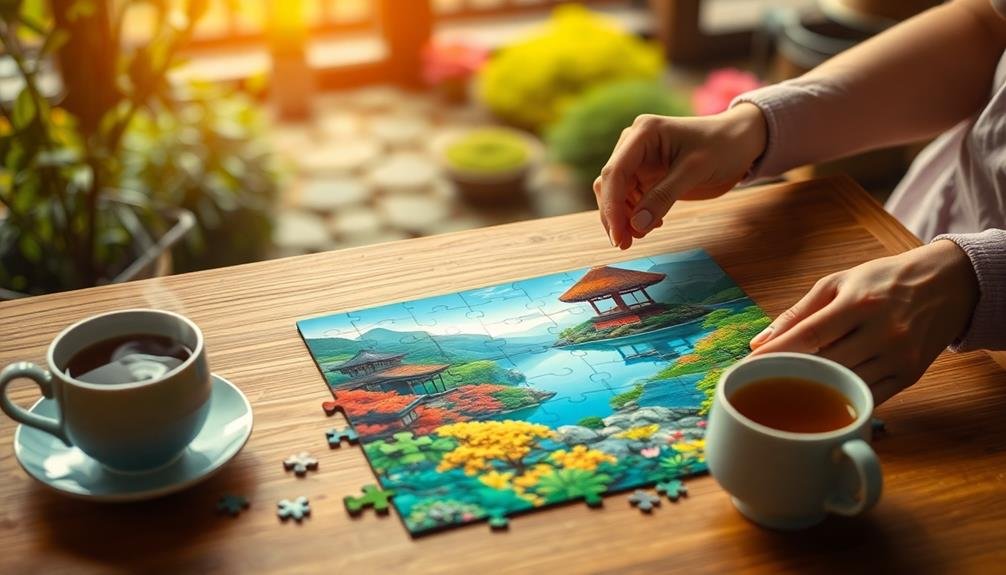
Jigsaw enthusiasts often discover that their puzzle-solving habit yields benefits far beyond immediate stress relief. As you consistently engage in this meditative activity, you'll notice gradual improvements in various cognitive and emotional areas.
Regular puzzling can enhance your problem-solving skills, boosting your ability to tackle complex issues in daily life. You'll also experience improved visual-spatial reasoning, which can positively impact your performance in tasks like navigation or design. Furthermore, puzzling may help maintain cognitive function as you age, potentially reducing the risk of memory-related disorders.
Here's a breakdown of long-term effects:
| Cognitive Benefits | Emotional Benefits |
|---|---|
| Improved memory | Increased patience |
| Enhanced focus | Stress reduction |
| Better reasoning | Mood stabilization |
| Sharper attention | Sense of achievement |
You'll likely find that these benefits extend to other areas of your life, enhancing your overall well-being. As you continue your puzzling journey, you may notice improved relationships, increased productivity at work, and a greater sense of calm in your daily routine. The cumulative effects of regular puzzling can contribute to a more balanced and fulfilling lifestyle.
Frequently Asked Questions
Can Jigsaw Puzzling Help Improve Memory and Cognitive Function in Older Adults?
Yes, jigsaw puzzling can boost your memory and cognitive function as you age. You'll exercise your brain, enhance problem-solving skills, and improve visual-spatial reasoning. It's a fun way to keep your mind sharp and engaged.
Are There Any Physical Health Benefits to Doing Jigsaw Puzzles Regularly?
Yes, you'll enjoy physical health benefits from regular puzzling. It can improve your fine motor skills, hand-eye coordination, and posture. You're also likely to experience lower blood pressure and reduced stress levels while engaging in this calming activity.
How Can I Preserve and Display Completed Puzzles as Art Pieces?
You can preserve completed puzzles by gluing them onto a sturdy backing. Frame them or mount them on canvas for display. Use puzzle glue or clear contact paper to seal the surface. Consider hanging them in themed groupings for impact.
What Are Some Creative Ways to Upcycle or Repurpose Old Puzzle Pieces?
You can transform old puzzle pieces into unique jewelry, create mosaic art, craft decorative coasters, or make eye-catching bookmarks. Try using them for scrapbooking embellishments, holiday ornaments, or even as colorful confetti for special occasions. Get creative and have fun!
Can Jigsaw Puzzling Be an Effective Team-Building Activity for Workplace Stress Reduction?
Yes, jigsaw puzzling can be a great team-building activity for workplace stress reduction. You'll collaborate, communicate, and problem-solve together. It's a fun, low-pressure way to bond with colleagues while taking a break from work-related tasks.
In Summary
You've now revealed the secrets to using jigsaw puzzles for stress relief. By applying these techniques, you'll transform a simple hobby into a powerful relaxation tool. Remember, it's not just about completing the puzzle; it's about the journey. As you continue to practice, you'll find your stress melting away with each piece you place. So, grab a puzzle, create your zen space, and let the calming effects wash over you. Happy puzzling!

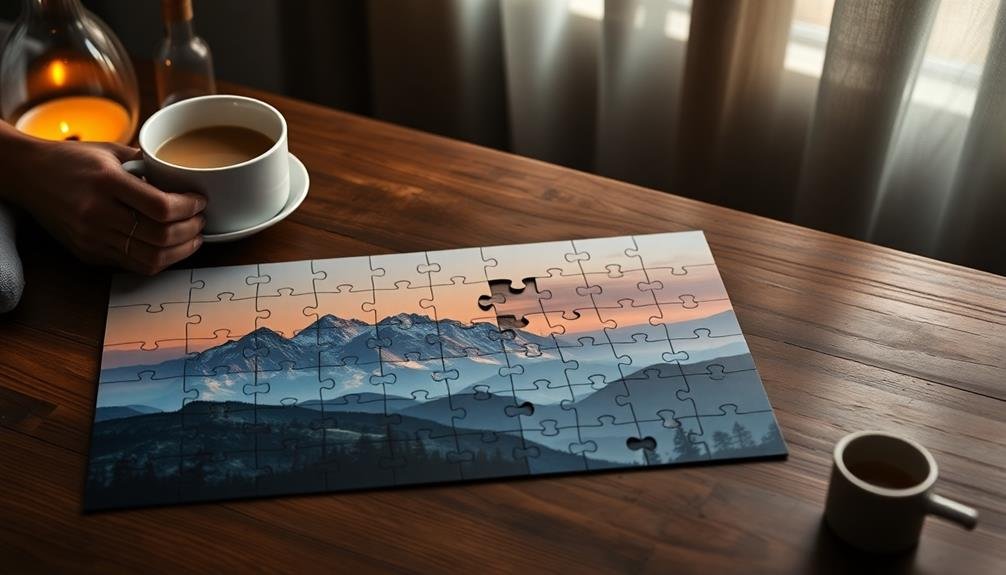



Leave a Reply